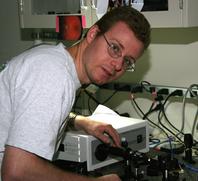Graduate Student Profile-Silas Leavesley
| Event Date: | June 12, 2006 |
|---|

"You have to have something to do outside of school."
This is how Silas Leavesley sums up his work with the University Church at Purdue, where he assists with maintenance, plays the piano, and leads the Sunday morning service along with his wife Heather. The question facing everyone else at the Weldon School is how Silas has any spare time at all.
First, he is the BME representative to the Graduate Student Government. In addition, he has taken on duties as the chair of the promotions committee. In that capacity, he has helped ensure that events are advertised, awareness raised with both students and departments about the graduate student government, and to ensure that important information reaches its intended audiences. "It's definitely been an interesting experience working to get every department at the University represented," he notes.
Second, he has taught undergraduate BME students after serving on the committee that designed the BME transport lab. "I enjoy teaching," he states. "It was a very neat experience, and I recommend teaching to anyone in the Ph.D. program." It was also clear that others enjoyed having him teach, as he was one of three from Weldon honored with the College of Engineering Magoon Award for Excellence in teaching.
Third, he owns a home and works on it. Actually, he, Heather, and the house are owned by Luke, a black & white American shorthair cat. "I chose it because the mortgage is less than the rent, and it is a much better deal than paying rent," he says.
Finally, there is his "real" work. As a graduate student working with Professor Paul Robinson in the imaging and flow cytometry lab, Silas has been busy.
He has developed and patented an endoscope that not only does traditional macroscopic imaging, but also allows microscopic imaging to be done simultaneously. Using this new device, doctors can visually detect areas for investigation, and then "zoom in" to a cellular level without the need for separate procedures. Leavesley is now working with undergraduate Molly Fu to develop methods to relate the macro and micro images, so that a complete guidance system for spatial orientation is available to physicians using the system.
His main research, however, is in helping pioneer the use of multispectral imaging for medical diagnostics. When an image is taken, many different wavelengths are combined to produce the image. What multispectral imaging does is to separate the different wavelengths or ranges, allowing chemicals, compounds, and different types of cells to stand out. In small animals, the focus of his research, it allows researchers to track the spread of medical dyes, drugs, and even bacteria.
Not only does this hold promise for improving animal and human healthcare, it opens new opportunities for assisting both pharmaceutical development and improving dosage rates. New drugs can be tracked to see if they go where they should and do as they should. Such tracking can also allow researchers to determine the proper amount of a drug needed for a given treatment.
This industry-funded research is scheduled to be functional by August and development completed by the end of the year. That works well for Silas, since it will then leave him a full year to perform any wrap-up research and complete his Ph.D thesis.
Yet, one fundamental question remains: where does he find the time?


